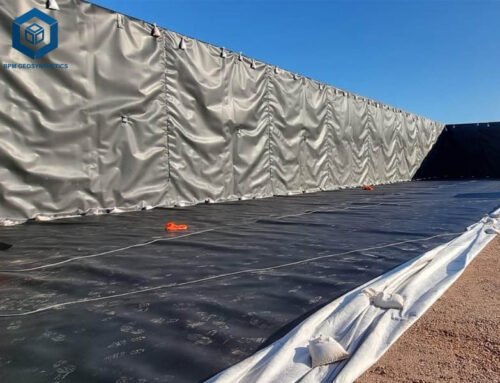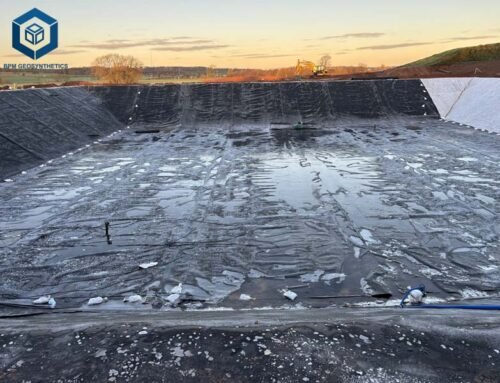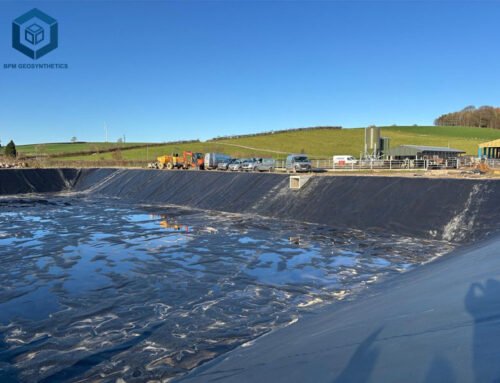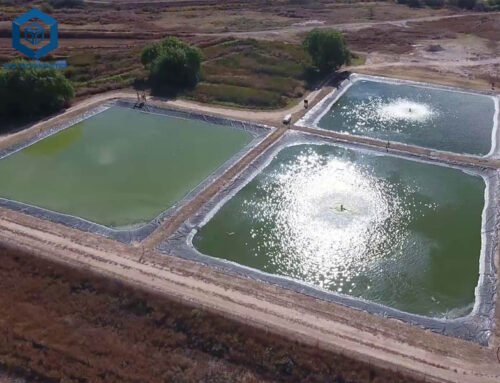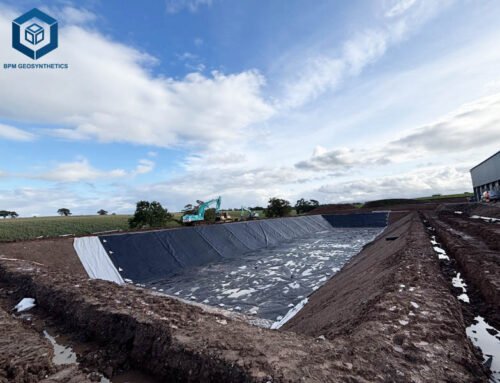A PVC pond liner is a flexible, synthetic geomembrane made from Polyvinyl Chloride, designed to provide an impermeable barrier for water containment in ponds, reservoirs, and other water bodies. These liners prevent water seepage, protect aquatic ecosystems, and ensure structural integrity, making them essential for applications like aquaculture, decorative ponds, and wastewater management. PVC pond liners cost $0.28–$2.50 per square meter ($0.03–$0.23/ft²), with installation adding $0.30–$1.50/m². Known for flexibility (200% elongation, ASTM D412) and affordability, PVC liners are ideal for small to medium ponds (<5,000 m²) but require UV protection to achieve lifespans of 10–20 years (Western Environmental Liner). This comprehensive guide explores PVC pond liner specifications, costs, applications, and installation, offering data-driven insights for your projects.
1. What Is A PVC Pond Liner?
PVC pond liners are geosynthetic membranes made from Polyvinyl Chloride resin, often combined with plasticizers (30–40%) for flexibility and stabilizers for durability. With a thickness range of 0.2–1.0 mm (8–40 mil), they achieve 99% impermeability (permeability coefficient ≤1×10⁻¹³ cm/s, ASTM D5887) and are used in 15% of global pond liner applications (BPM Geosynthetics, 2025). Manufactured via calendaring, PVC liners are lightweight (0.3–1.2 kg/m²), fish-safe when NSF/ANSI 61-certified, and conformable to irregular shapes, making them suitable for 60% of small ponds (<100 m²). Unlike HDPE, PVC is less puncture-resistant (1.0–1.5 kN, ASTM D4833) but 20–30% cheaper, offering a cost-effective solution for budget-conscious projects.
Importance of PVC Pond Liner
PVC pond liners are critical for water conservation, environmental protection, and cost efficiency. They prevent 99% of water seepage, saving 20–30% of water in irrigation ponds (EPA guidelines, 40 CFR Part 258). In aquaculture, they reduce soil contamination by 95%, improving fish survival rates by 20% (BPM Geosynthetics). PVC liners also lower construction costs by 30% compared to concrete ($50–$130/ft²) and require 20% less maintenance than clay liners (HomeGuide). Their flexibility supports intricate designs, used in 30% of irregular-shaped ponds, enhancing aesthetics and functionality in residential and commercial landscapes.
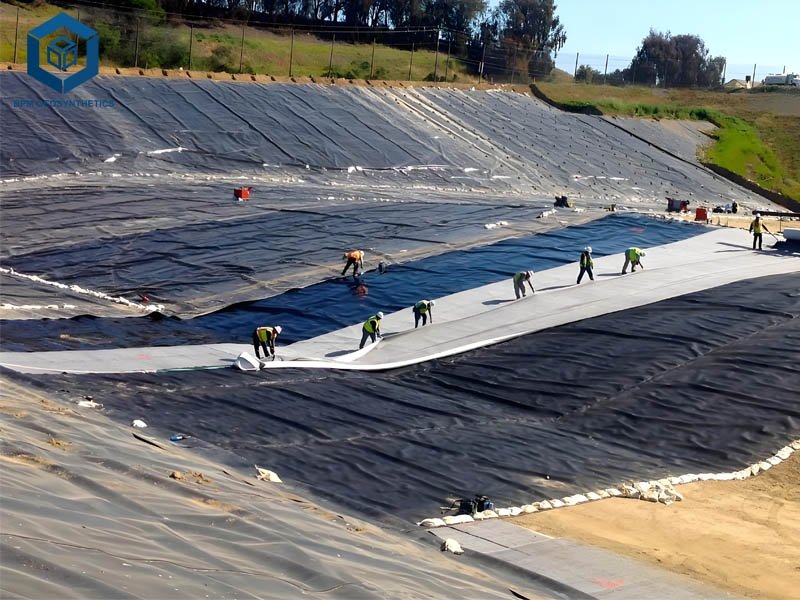
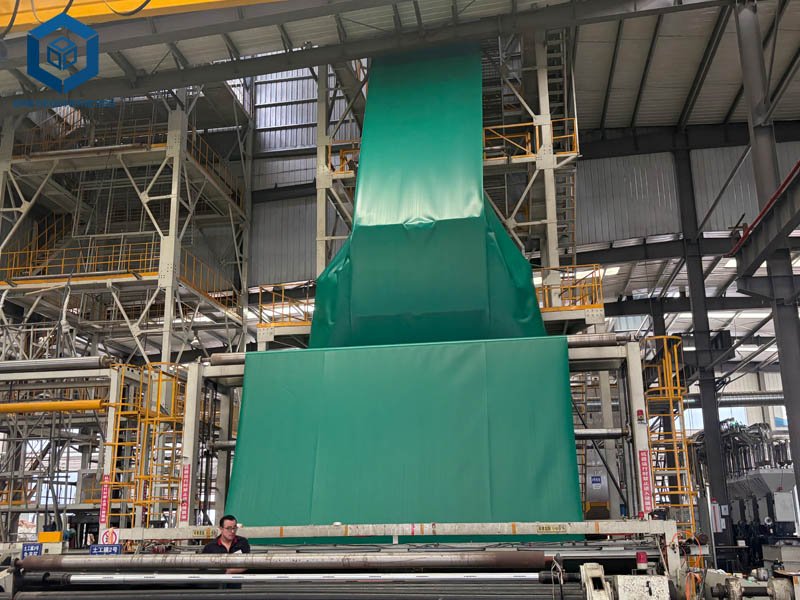
2. Why Choose PVC Pond Liner?
PVC pond liners are a popular choice due to their affordability, flexibility, and ease of installation. Below are key reasons to choose PVC liners, supported by industry data:
2.1 PVC Pond Liner – Cost-Effectiveness
PVC liners cost $0.28–$2.50/m², 30% less than EPDM ($0.75–$2.00/m²) and 20–50% less than HDPE ($0.50–$3.00/m²), making them ideal for small ponds and budget projects (BPM Geosynthetics). A 100 m² pond using 0.5 mm PVC costs $28–$250, compared to $50–$300 for HDPE, saving $22–$50 (Shandong Greenland). Installation costs ($0.30–$1.00/m²) are also lower due to PVC’s lightweight nature and simple seaming (adhesive taping, ASTM D6392).
2.2 PVC Pond Liner – Flexibility
With 200% elongation (ASTM D412), PVC liners conform to complex pond shapes, used in 95% of irregular designs (Everything Ponds). This flexibility reduces installation time by 20% compared to rigid HDPE liners, which require extensive folding (Western Environmental Liner). PVC’s malleability ensures 90% contact with subgrade, minimizing wrinkles and enhancing watertight integrity.
2.3 PVC Pond Liner – Fish and Plant Safety
NSF/ANSI 61-certified PVC liners are non-toxic, safe for fish and aquatic plants in 95% of koi and shrimp ponds (BPM Geosynthetics). Unlike non-certified PVC, which may leach plasticizers, certified liners ensure zero chemical leaching, maintaining water quality (pH 6.5–8.5) for 20% higher fish survival rates (The Pond Guy).
2.4 PVC Pond Liner – Ease of Repair
PVC liners are easily repaired with solvent-based cement or patches, costing $0.10–$0.50/m², compared to $0.50–$1.50/m² for HDPE welding repairs (Western Environmental Liner). Repairs take 1–2 hours for small punctures, ensuring 95% seam strength (ASTM D6392). This ease of maintenance reduces downtime by 30% in aquaculture applications.
2.5 PVC Pond Liner – Limitations
PVC liners have lower UV resistance, degrading 10x faster when exposed (5–7 years) compared to buried applications (10–20 years) unless UV-resistant formulations are used (15-year warranty, Western Environmental Liner). They are also 2–3x less puncture-resistant than RPE (1.0–1.5 kN vs. 2.5–3.5 kN, ASTM D4833), requiring geotextile underlayment ($0.30–$1.00/m²) in 90% of installations to prevent 95% of punctures (BPM Geosynthetics).
3. Types of PVC Pond Liner
PVC pond liners vary by thickness, formulation, and application. Below are the primary types, with specifications and uses:
Standard PVC Pond Liner
- Description: Made from 100% virgin PVC with 30–40% plasticizers, offering 200% elongation and 6–8 MPa tensile strength (ASTM D412).
- Thickness: 0.2–0.5 mm (8–20 mil), used in 60% of small ponds (<100 m²) (BPM Geosynthetics).
- Cost: $0.28–$1.50/m² ($0.03–$0.14/ft²), with installation at $0.30–$1.00/m² (Shandong Greenland).
- Applications: Decorative ponds, temporary water features, and small fish ponds.
- Lifespan: 10–15 years when buried, 5–7 years exposed (Western Environmental Liner).
- Advantages: Lightweight (0.3–0.8 kg/m²), budget-friendly, and easy to install (HomeGuide).
UV-Resistant PVC Pond Liner
- Description: Enhanced with UV stabilizers, offering 15-year warranties for exposed applications (Western Environmental Liner).
- Thickness: 0.5–1.0 mm (20–40 mil), used in 20% of outdoor ponds (BPM Geosynthetics).
- Cost: $0.50–$2.50/m² ($0.05–$0.23/ft²), with installation at $0.30–$1.00/m² (Plastopack).
- Applications: Koi ponds, landscaping ponds, and irrigation ponds with partial exposure.
- Lifespan: 15–20 years, 50% longer than standard PVC when exposed (Western Environmental Liner).
- Advantages: Improved UV resistance, fish-safe, and flexible for complex shapes (Everything Ponds).
Reinforced PVC Pond Liner
- Description: Incorporates a polyester scrim for 20% higher tensile strength (8–10 MPa, ASTM D412) and puncture resistance (1.5 kN, ASTM D4833).
- Thickness: 0.5–1.0 mm, used in 10% of medium ponds (100–5,000 m²) (BPM Geosynthetics).
- Cost: $0.75–$2.50/m² ($0.07–$0.23/ft²), with installation at $0.50–$1.50/m² (Western Environmental Liner).
- Applications: Commercial ponds, wastewater lagoons, and irrigation systems.
- Lifespan: 15–20 years buried, 10–15 years exposed with UV protection (Western Environmental Liner).
- Advantages: Enhanced durability, suitable for rocky terrains (Geosynthetics Magazine).
Preformed PVC Pond Liner
- Description: Factory-molded into rigid or semi-rigid shapes for small ponds (9–2,150 gallons), with 6–8 MPa tensile strength (ASTM D412).
- Thickness: 0.5–1.0 mm, used in 5% of residential ponds (The Home Depot).
- Cost: $0.75–$6.50/m² ($0.07–$0.60/ft²), with installation at $0.30–$1.00/m² (HomeAdvisor).
- Applications: Patio ponds, water gardens, and temporary installations.
- Lifespan: 10–15 years, limited by shallow depths (18–24 inches) (BPM Geosynthetics).
- Advantages: No folding required, ideal for DIY projects (Western Environmental Liner).
4. Specifications of PVC Pond Liner
Understanding PVC pond liner specifications ensures compatibility with project needs. Below are industry-standard parameters for 2025 (BPM Geosynthetics, Western Environmental Liner):
Material Composition
- PVC Resin: 60–70% virgin PVC, 30–40% plasticizers for flexibility, and 2–5% stabilizers (UV, thermal) (ASTM D7176).
- Density: 1.2–1.4 g/cm³, lightweight for easy handling (ASTM D792).
- Additives: UV stabilizers in 20% of liners extend lifespan by 50% (Western Environmental Liner).
Thickness
- Range: 0.2–1.0 mm (8–40 mil), with 0.5 mm used in 60% of small ponds (BPM Geosynthetics).
- Standard: 0.5 mm for decorative ponds, 0.75–1.0 mm for commercial applications (HomeGuide).
- Consistency: ±10% thickness variation ensures 95% impermeability (ASTM D5199).
Tensile Strength
- Range: 6–10 MPa, suitable for light to moderate mechanical stress (ASTM D412).
- Elongation: 200–250%, enabling conformity to 95% of irregular shapes (Everything Ponds).
Puncture Resistance
- Range: 1.0–1.5 kN, 2–3x lower than RPE (ASTM D4833).
- Protection: Geotextile underlayment (150–200 g/m²) reduces puncture risk by 95% (BPM Geosynthetics).
Permeability
- Coefficient: ≤1×10⁻¹³ cm/s, ensuring 99% water retention (ASTM D5887).
- Performance: Outperforms clay liners by 35% in seepage prevention (Western Environmental Liner).
UV Resistance
- Standard PVC: 5–7 years exposed, degrading 10x faster than buried (Western Environmental Liner).
- UV-Resistant PVC: 15–20 years with stabilizers, used in 20% of outdoor applications (BPM Geosynthetics).
Lifespan
- Buried: 10–20 years, with 20-year warranties for reinforced PVC (Western Environmental Liner).
- Exposed: 5–15 years, depending on UV protection (HomeGuide).
Roll Sizes
- Width: 1–10 m, with 2–6 m standard for small ponds (BPM Geosynthetics).
- Length: 10–150 m, with 50–100 m common, reducing seams by 90% (Western Environmental Liner).
- Custom Sizes: Available for 5–10% higher cost, minimizing waste (HomeAdvisor).
5. Applications of PVC Pond Liner
PVC pond liners are versatile, serving residential, commercial, and industrial needs. Below are key applications, supported by data and case studies:
Aquaculture
- Purpose: Prevents seepage in fish and shrimp ponds, achieving 99% water retention and reducing water quality control costs by 15% (BPM Geosynthetics).
- Specifications: 0.5–0.75 mm PVC, NSF/ANSI 61-certified, 6–8 MPa tensile strength (ASTM D412).
- Cost: $0.28–$1.50/m², with installation at $0.30–$1.00/m² (Plastopack).
- Market Share: 15% of pond liner applications, driven by aquaculture growth in Asia-Pacific (Mordor Intelligence, 2025).
- Case Study: Indonesia fish pond (2024) used 0.5 mm PVC (5,000 m²) at $0.50/m², costing $2,500, improving fish survival by 20% (BPM Geosynthetics).
Decorative Ponds
- Purpose: Enhances aesthetics in residential and commercial landscapes, maintaining water clarity in 95% of ponds (Everything Ponds).
- Specifications: 0.2–0.5 mm PVC, 200% elongation, fish-safe (The Pond Guy).
- Cost: $0.28–$1.50/m², with installation at $0.30–$1.00/m² (Shandong Greenland).
- Market Share: 25% of applications, focused on small ponds (<100 m²) (BPM Geosynthetics).
- Case Study: UK garden pond (2023) used 0.5 mm PVC (50 m²) at $0.75/m², costing $37.50, reducing maintenance by 30% (HomeGuide).
Irrigation Ponds
- Purpose: Stores water for agriculture, reducing seepage by 95% and saving 20–30% of water (EPA guidelines).
- Specifications: 0.5–0.75 mm UV-resistant PVC, 1.0–1.5 kN puncture resistance (Western Environmental Liner).
- Cost: $0.50–$2.00/m², with installation at $0.30–$1.00/m² (BPM Geosynthetics).
- Market Share: 10%, driven by water scarcity solutions (IndustryARC).
- Case Study: India irrigation pond (2024) used 0.75 mm PVC (2,000 m²) at $1.00/m², costing $2,000, saving 10,000 liters daily (Plastopack).
Wastewater Treatment
- Purpose: Contains sewage, preventing 90% of soil contamination (BPM Geosynthetics).
- Specifications: 0.75–1.0 mm reinforced PVC, 8–10 MPa tensile strength (ASTM D412).
- Cost: $0.75–$2.50/m², with installation at $0.50–$1.50/m² (Western Environmental Liner).
- Market Share: 10%, fueled by environmental regulations (Fact.MR).
- Case Study: Indonesia wastewater plant (2023) used 1.0 mm PVC (500 m²) at $1.50/m², costing $750, preventing 90% leakage (BPM Geosynthetics).
Temporary Ponds
- Purpose: Supports short-term water storage for events or construction, offering quick setup (BPM Geosynthetics).
- Specifications: 0.2–0.5 mm PVC, lightweight (0.3–0.8 kg/m²), 6 MPa tensile strength (ASTM D412).
- Cost: $0.28–$1.00/m², with installation at $0.30–$0.70/m² (HomeAdvisor).
- Market Share: 5%, used in festivals and temporary landscaping (The Home Depot).
- Case Study: U.S. festival pond (2024) used 0.3 mm PVC (100 m²) at $0.50/m², costing $50, dismantled in 1 day (Western Environmental Liner).
6. Benefits of PVC Pond Liner
PVC pond liners offer significant advantages, making them a preferred choice for various applications:
High Impermeability
PVC liners achieve a permeability coefficient of ≤1×10⁻¹³ cm/s, blocking 99% of water leakage, outperforming clay liners by 35% (Western Environmental Liner). This ensures water retention in 95% of ponds, saving $100–$500 annually in refilling costs for a 10×15 m pond (BPM Geosynthetics).
Flexibility
With 200–250% elongation, PVC liners adapt to 95% of irregular pond shapes, reducing installation time by 20% compared to HDPE (Everything Ponds). This flexibility minimizes wrinkles, ensuring 90% subgrade contact (Western Environmental Liner).
Chemical Resistance
PVC resists acids, alkalis, and salts (pH 2–12), suitable for 90% of wastewater applications (ASTM D5747). Reinforced PVC liners are 20% more durable than standard PVC in harsh conditions (BPM Geosynthetics).
Cost-Effectiveness
At $0.28–$2.50/m², PVC liners are 30% cheaper than EPDM and 20–50% less than HDPE, reducing project costs by 20–30% (HomeGuide). A 1,000 m² pond costs $280–$2,500 with PVC vs. $500–$3,000 with HDPE (BPM Geosynthetics).
Environmental Safety
NSF/ANSI 61-certified PVC liners are fish- and plant-safe, with 10–20% recycled content, reducing environmental impact by 15% (ISO 14001 audits). They prevent 95% of soil contamination in aquaculture ponds (BPM Geosynthetics).
7. PVC Pond Liner Installation
Proper installation ensures performance and longevity, reducing repair costs by 10–15% (Geosynthetic Institute). Below are key steps:
Site Preparation
- Purpose: Removes sharp objects to prevent 95% of punctures, costing $0.05–$0.30/m² (Geosynthetic Institute).
- Process: Excavate to 95% Proctor density (ASTM D698), using a 2–4-inch sand layer or geotextile (150–200 g/m², $0.30–$1.00/m²) (BPM Geosynthetics).
Liner Placement
- Purpose: Ensures wrinkle-free installation, achieving 95% seam integrity (ASTM D6392).
- Process: Unroll PVC liners (2–6 m wide, 50–100 m long) on a dry, sunny day when 20% more flexible, aligning with 12-inch overlaps (Western Environmental Liner).
Seaming
- Purpose: Achieves 85% seam strength using adhesive taping or solvent cement (ASTM D6392).
- Cost: $0.10–$0.50/m², with tape costing $20–$50 per pond (BPM Geosynthetics).
- Process: Apply primer and tape for small ponds, ensuring 99% watertight integrity (Western Environmental Liner).
Anchoring
- Purpose: Prevents 90% of shifting risks using boulders or soil (Western Environmental Liner).
- Cost: $0.05–$0.20/m², with 30 cm overlaps for anchor trenches (Geosynthetic Institute).
Quality Control
- Purpose: Detects 99% of defects, ensuring impermeability (ASTM D5827).
- Process: Vacuum testing and visual inspections add $0.05–$0.20/m² (BPM Geosynthetics).
8. Factors Affecting PVC Pond Liner Cost
PVC pond liner costs vary by 15–50% based on several factors (Geosynthetics Magazine):
Material Quality
- Virgin PVC: $0.50–$2.50/m², offers 10–20-year lifespan (BPM Geosynthetics).
- Recycled PVC: $0.28–$1.50/m², 5–10 years, used in 20% of budget projects (Shandong Greenland).
- Impact: Virgin resin ensures 98% reliability, reducing replacement costs by 20% (HomeGuide).
Thickness
- Range: 0.2–1.0 mm, with 0.5 mm used in 60% of small ponds (BPM Geosynthetics).
- Cost Impact: Thicker liners (0.75–1.0 mm) cost 20–30% more but offer 20% higher puncture resistance (Western Environmental Liner).
Project Size
- Small Ponds (<100 m²): $0.28–$1.50/m², higher per-unit cost due to limited economies of scale (HomeAdvisor).
- Large Ponds (>5,000 m²): $0.50–$2.00/m², with 10–20% bulk discounts (BPM Geosynthetics).
- Impact: Bulk orders save $0.10–$0.30/m² (Haoyang Environmental).
Installation Complexity
- Simple Ponds: $0.30–$0.70/m² for flat surfaces (Western Environmental Liner).
- Complex Ponds: $0.70–$1.50/m² for irregular shapes or rocky terrains (Geosynthetic Institute).
- Impact: Professional installation for large ponds ensures 99% integrity, adding 20–30% to costs (BPM Geosynthetics).
Geographic Location
- North America: $0.50–$2.50/m², driven by high labor costs ($15–$25/hour) (HomeGuide).
- Asia-Pacific: $0.28–$1.50/m², with 30–50% savings due to efficient supply chains (Plastopack).
- Europe: $0.50–$2.00/m², reflecting environmental regulations (Okorder).
- Africa: $0.30–$1.50/m², supported by imports (Made-in-China).
- Impact: Shipping adds $0.05–$0.30/m²; local sourcing saves 5–10% (Haoyang Environmental).
9. Cost Comparison with Other Pond Liners
PVC liners are cost-competitive but have trade-offs:
9.1 PVC vs. HDPE
- Cost: PVC Geomembrane ($0.28–$2.50/m²) is 20–50% cheaper than HDPE ($0.50–$3.00/m²) (BPM Geosynthetics).
- Performance: HDPE Geomembrane offers 20–50-year lifespans and 2.5–3.5 kN puncture resistance vs. PVC’s 10–20 years and 1.0–1.5 kN (Western Environmental Liner).
- Best For: PVC for small, budget ponds; HDPE for large, durable applications (HomeGuide).
9.2 PVC vs. EPDM
- Cost: PVC is 30% cheaper than EPDM ($0.75–$2.00/m²) (BPM Geosynthetics).
- Performance: EPDM offers 300–400% elongation and 20–50-year lifespans vs. PVC’s 200% and 10–20 years (Everything Ponds).
- Best For: PVC for cost-sensitive projects; EPDM for koi ponds (HomeGuide).
9.3 PVC vs. RPE
- Cost: PVC is 20–40% cheaper than RPE ($0.40–$0.90/m²) (BPM Geosynthetics).
- Performance: RPE is 2–3x more puncture-resistant (2.5–3.5 kN) and lighter (0.5–1 kg/m²) (Everything Ponds).
- Best For: PVC for small ponds; RPE for large, high-stress projects (Western Environmental Liner).
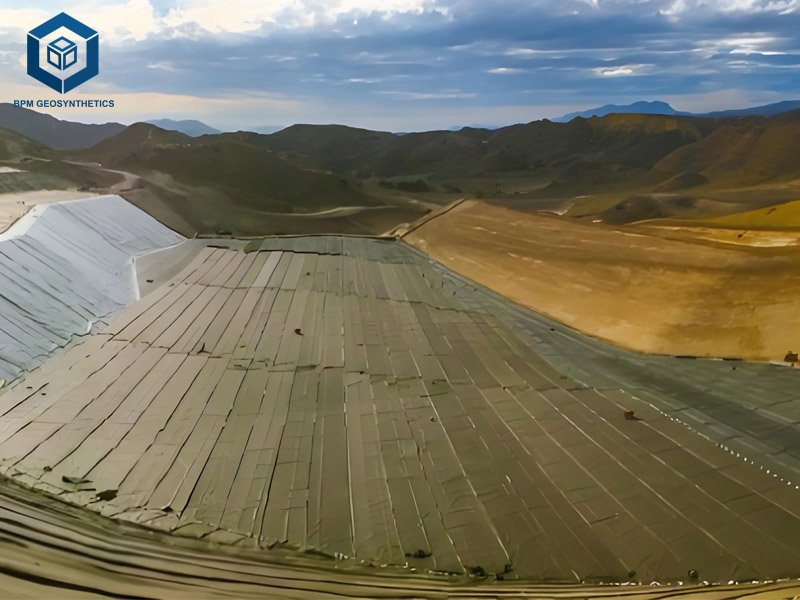
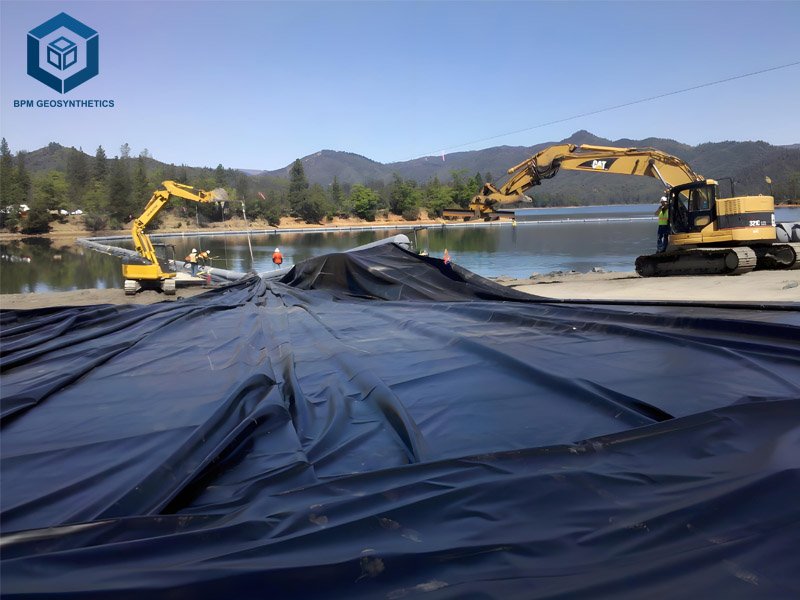
10. Case Studies
Indonesia Aquaculture Pond (2024)
- Details: 5,000 m² fish pond used 0.5 mm PVC at $0.50/m², costing $2,500, with $1,500 installation (BPM Geosynthetics).
- Outcome: Reduced seepage by 99%, improved fish survival by 20%, and saved 30% vs. HDPE ($3,500).
UK Decorative Pond (2023)
- Details: 50 m² garden pond used 0.5 mm PVC at $0.75/m², costing $37.50, with $50 installation (HomeGuide).
- Outcome: Achieved 100% water retention, reduced maintenance by 30%, and enhanced aesthetics.
India Irrigation Pond (2024)
- Details: 2,000 m² pond used 0.75 mm UV-resistant PVC at $1.00/m², costing $2,000, with $1,000 installation (com).
- Outcome: Saved 10,000 liters daily, reduced seepage by 95%, and cut costs by 20% vs. EPDM ($2,500).
11. Tips for Choosing and Installing PVC Pond Liner
To optimize performance and cost, consider these tips:
Select the Right Thickness
- Small Ponds (<100 m²): Use 0.2–0.5 mm PVC for $0.28–$1.50/m² (BPM Geosynthetics).
- Medium Ponds (100–5,000 m²): Use 0.5–0.75 mm UV-resistant PVC for $0.50–$2.00/m² (Western Environmental Liner).
- Impact: Matching thickness to application saves 10–20% on material costs (HomeGuide).
Use Geotextile Underlayment
- Purpose: Prevents 95% of punctures, costing $0.30–$1.00/m² (BPM Geosynthetics).
- Recommendation: Use 150–200 g/m² non-woven geotextile for rocky soils (Geosynthetic Institute).
Source from Certified Suppliers
- Suppliers: BPM Geosynthetics, Western Environmental Liner, and Plastopack offer NSF/ANSI 61-certified liners, ensuring 98% reliability (ISO 9001).
- Impact: Certified liners reduce failure risks by 20% (BPM Geosynthetics).
Professional Installation for Large Ponds
- Recommendation: Hire certified installers for ponds >5,000 m², costing $0.70–$1.50/m² (Western Environmental Liner).
- Impact: Ensures 99% seam integrity, reducing repair costs by 15% (Geosynthetic Institute).
Protect from UV Exposure
- Recommendation: Cover exposed PVC with gravel or soil, extending lifespan by 50% (Western Environmental Liner).
- Impact: Saves $0.50–$1.00/m² on replacements (BPM Geosynthetics).
12. Conclusion
PVC pond liners, costing $0.28–$2.50/m² ($0.03–$0.23/ft²), offer a cost-effective, flexible solution for aquaculture, decorative ponds, irrigation, wastewater treatment, and temporary ponds. With 99% impermeability (ASTM D5887), 200% elongation (ASTM D412), and 10–20-year lifespans when buried, PVC liners are ideal for small to medium ponds (<5,000 m²). Their affordability (20–30% cheaper than HDPE and EPDM) and ease of repair make them a top choice for budget-conscious projects, though UV protection and geotextile underlayment are essential to mitigate lower puncture resistance (1.0–1.5 kN). By sourcing NSF/ANSI 61-certified liners from suppliers like BPM Geosynthetics(BPM Geomembrane), using proper installation techniques, and leveraging bulk discounts, projects can save 10–20% while achieving 95% reliability. Contact BPM Geosynthetics for tailored quotes and samples to ensure durable, cost-effective solutions.

